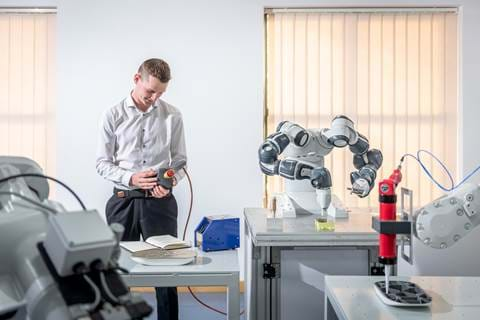Me, Myself and AI
What the future holds for aerospace and defence

For over 70 years Chelton has helped shape the aerospace and defence industry and today is recognised as a major player in the market. We can talk endlessly about our journey from the 1940s to present day but what does the future have in store for aerospace and defence? It’s near on impossible to exactly predict how technologies and their uses will develop over the next 50 years but by entrenching ourselves into our customer’s daily operations, their requirements and innovations with new technologies, we can help to shape the future.
Imagine its 2071, you’ve booked your summer spree to space and you can transport a digital version of yourself to different places. But what key themes will we see appear in the future of avionic design and manufacturing?

The mere mention of ‘robots’ often creates the misconception that the human workforce will be entirely replaced which in turn creates resistance in the adoption of robots into a business. However, this could not be further from the truth. In the future, robots will work harmoniously WITH humans to create a more efficient, productive and successful outcome. Accenture reports that 72% of aerospace and defence executives believe organisations need to dramatically reengineer the experiences that bring technology and people together in a more human-centric way
We are already integrating cobots into our processes where the robot arms will carry out manufacturing and testing tasks that employees programme it to, based on their experience. Employees will instead be empowered and motivated to upskill to higher value added roles, rather than the repetitive and time-consuming tasks their robot counterparts could easily complete.


Cobots will increase precision and repeatability while limiting human error. But this can be taken one step further with Artificial Intelligence. Using data from past experiences and projects will allow cobots and automated processes to be able to think for themselves and make decisions to drive further efficiency. We can all agree that robots can work well on an assembly line but can they ever be intelligent? The ultimate goal of AI is to recreate the human thought process with the ability to learn, reason and formulate original ideas. At present, robots are fed intelligence by the human workforce based on their experience in design and manufacturing. This gives them the ability to make decisions themselves on whether a product or component will pass the pass/fail threshold it sets based on fed information. However, could we see robots and computing software make these decisions themselves by learning from past experiences or even creating their own ideas based on research? The likelihood of a robot becoming a fully functioning and free-thinking brain is a very real possibility but the lead up to this point will surely involve a lot of learning from humans.
The 21st century has seen some of the most extreme and rapid technological advances. There are even some predictions that by 2050, half of all people will work in roles that don’t currently exist. With the increase in automation, engineering will still exist but the paradigm will shift to a more flexible skill set with a mix of hard, technical skills and soft, interpersonal ones. The meticulousness of engineers will be blended with creativity, design and statistical analysis; a cocktail of cleverness that cannot be replicated by a machine. This engineering workforce, which will see a more balanced mix of male and female workers interested in STEM careers, will continue to drive forward progress.

![F 35[4] Medium](/media/t2jdbmbv/f-35-4-medium.jpg?anchor=center&mode=crop&width=480&height=0&format=jpg&quality=70&rnd=132641965775100000)
With mounting pressure on public resources and budgets, as well as the drive to a more sustainable world, there is an increasing need for more efficient avionics. Unlike electric vehicles, in the world of aviation, it’s not as easy as simply making everything electric. Instead, efficiency will be driven by way of new materials and processes powered by alternative energy sources to create cleaner and quieter equipment with optimum SWaP. The industry has largely led the world in the development of the lightest alloys, composites and specialist materials, and has already sown the seeds of efficiency with the introduction of programmes like F35 and now Future Vertical Lift, where a common thread across a number of platforms can be extrapolated across tri-force use. Multi-domain solutions sharing a common footprint will deliver adaptability and a lower total life-cycle cost ensuring that platforms are ready for their mission now and in the future.
With all these trends in mind, Chelton predicts the following opportunities for the aerospace and defence industry:
We’ve blazed the trail for over 70 years and intend to do so for at least 70 more.

Your quote basket is currently empty
 Please select the type of quote you require for this product:
Please select the type of quote you require for this product: